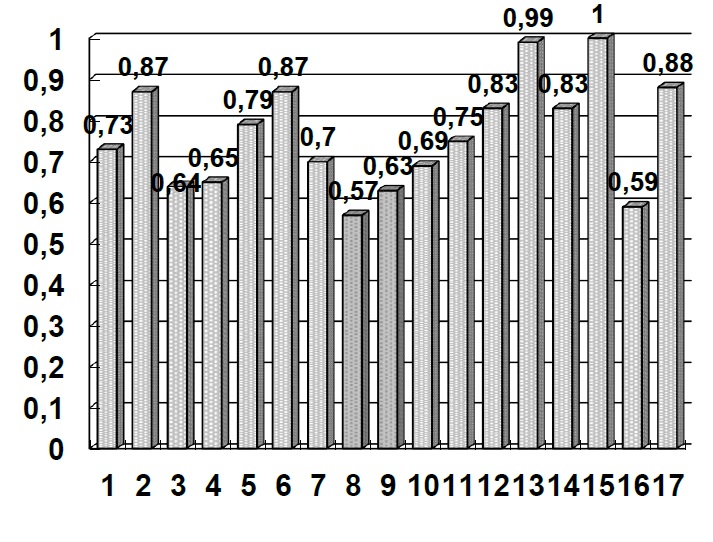The main indicators for assessing the level of military danger
Abstract
The article deals with approaches to the choice of indicators of military danger in order to carry out an assessment of threats to the national interests of the state. The attention is focused on the acute need for a careful attitude to the analysis of the dynamics of changes in the military-political situation and the assessment of the level of military danger for Ukraine. It is formulated the necessity of using the scientific approach to the forecast of the level of military danger for Ukraine as a geopolitical player.
An overview of existing research and publications of specialists in the national security strategy on the investigation of threats to national interests in the military field has shown that existing approaches are sufficiently developed and informative. In conducted research, military danger is considered as the potential ability of any state (group of states) to use military force to solve interstate political, economic, military, ethnic, religious and other contradictions. And this potential opportunity is constantly threatening the national interests of Ukraine, which can lead to different forms of armed confrontation. At the same time, the ambiguity in certain theoretical positions raises the need to clarify the definition of the most dangerous threats to national interests in the military sphere, and the constant transformations of the theory of military security of the state further complicate the solution of this problem. Therefore, in the interests of deeper formalization of geopolitical processes and taking into account their impact on the level of military danger, the application of the appropriate system of indicators is proposed.
To assess the level of military danger for Ukraine, it is proposed to select 17 indicators that can be used together in the procedures for determining the level of military danger to Ukraine by other states. The use of separate values of the relevant indicators of military danger during the prediction of changes in the military-political situation can be used to substantiate the relevant decisions in the bodies of state military management.
Downloads
References
Sahaniuk F.V. (2018). Sektor bezpeky i oborony Ukrayiny: stratehichne kerivnytstvo ta viyskove upravlinnia: monohrafiia [The Ukrainian Security and Defense Sector: Strategic Leadership and Military Management: A Monograph]. Kyiv, Р. 230 [in Ukrainian].
Rusnak I.S. (2015). Voienna bezpeka Ukrayiny u svitli reformuvannia sektora bezpeky i oborony [Military security of Ukraine in the light of the reform of the security and defense sector]. Nauka i oborona, 2, Р. 9 – 14 [in Ukrainian].
Horbulin V.P. (2014). “Hibrydna viyna” yak kliuchonyi instrument rosiyskoyi heostratehiyi revanshu ["Hybrid War" as a key tool for Russian geostrategy of revenge]. Stratehichni priorytety, Р. 4 [in Ukrainian].
Syrotenko A.M. (2017). Metodyka proektuvannia neobkhidnykh spromozhnostey skladovykh intehrovanoho potentsialu protydiyi zahrozam na vykonavchomu rivni [The necessary abilities of integrated capacity designing methodology for responding to threats at the executive level], 3 (81), 48 – 56 р. [in Ukrainian].
Duz-Kriatchenko O.P. Osnovy stratehiyi natsionalnoyi bezpeky ta oborony derzhavy (2015) [Fundamentals of the National Security and Defense Strategy] Kyiv, NDUU, р. 620 [in Ukrainian].
Bohdanovych V.Y. (2012) Teoretyko-metodolohichni osnovy zabezpechennia natsionalnoyi bezpeky Ukrayiny: monohrafiya: u 7 t. T.1. Teoretychni osnovy, metody y tekhnolohiyi zabezpechennya natsionalnoyi bezpeky Ukrayiny [Theoretical and methodological bases for ensuring national security of Ukraine]. Kyiv, р. 548 [in Ukrainian].
Voyenna doktryna Ukrayiny. Zatverdzhena Ukazom Prezydenta Ukrayiny vid 24 veresnia 2015 roku № 555/2015 [Military doctrine of Ukraine. Approved by the Decree of the President of Ukraine dated September 24, 2015, No. 555/2015] [in Ukrainian].
Kosevtsov V.O., Telelym V.M., Shevchenko V.I. (1998). Otsinka stanu voiennoyi bezpeky Ukrayiny [Assessment of the state of military security of Ukraine]. Nauka i oborona, 2, 3 – 6 [in Ukrainian].
Bohdanovych V.Y., Manachynskyi A.Y. (2001). Metodolohicheskiie osnovy sistemnyh issledovaniy problem voiennoy bezopasnosti hosudarstva [Methodological foundations of systems research on the state’s military security]. Kyiv, р. 172 [in Russian].
Kosevtsov V.O. Ukrayina v systemi viyskovo-politychnykh vidnosyn z susidnimy krayinamy: kilkisnyi vymir (1996) [Ukraine in the System of Military-Political Relations with Neighboring Countries: Quantitative Dimension] Kyiv, NISD, р. 40 [in Ukrainian].
Kosevtsov V.O., Binko I.F., Matviievskyi O.M. (1995). Metodychnyi pidhid do analizu y otsinky rivnia natsionalnoyi bezpeky ta yiyi skladovykh [Methodical approach to the analysis and assessment of the level of national security and its components]. Nauka i oborona, 1, р. 74 – 77 [in Ukrainian].

Abstract views: 614 PDF Downloads: 420
Copyright (c) 2019 Spartak Hohoniants

This work is licensed under a Creative Commons Attribution 4.0 International License.
The authors agree with the following conditions:
1. Authors retain copyright and grant the journal right of first publication (Download agreement) with the work simultaneously licensed under a Creative Commons Attribution License that allows others to share the work with an acknowledgment of the work's authorship and initial publication in this journal.
2. Authors have the right to complete individual additional agreements for the non-exclusive spreading of the journal’s published version of the work (for example, to post work in the electronic repository of the institution or to publish it as part of a monograph), with the reference to the first publication of the work in this journal.
3. Journal’s politics allows and encourages the placement on the Internet (for example, in the repositories of institutions, personal websites, SSRN, ResearchGate, MPRA, SSOAR, etc.) manuscript of the work by the authors, before and during the process of viewing it by this journal, because it can lead to a productive research discussion and positively affect the efficiency and dynamics of citing the published work (see The Effect of Open Access).















